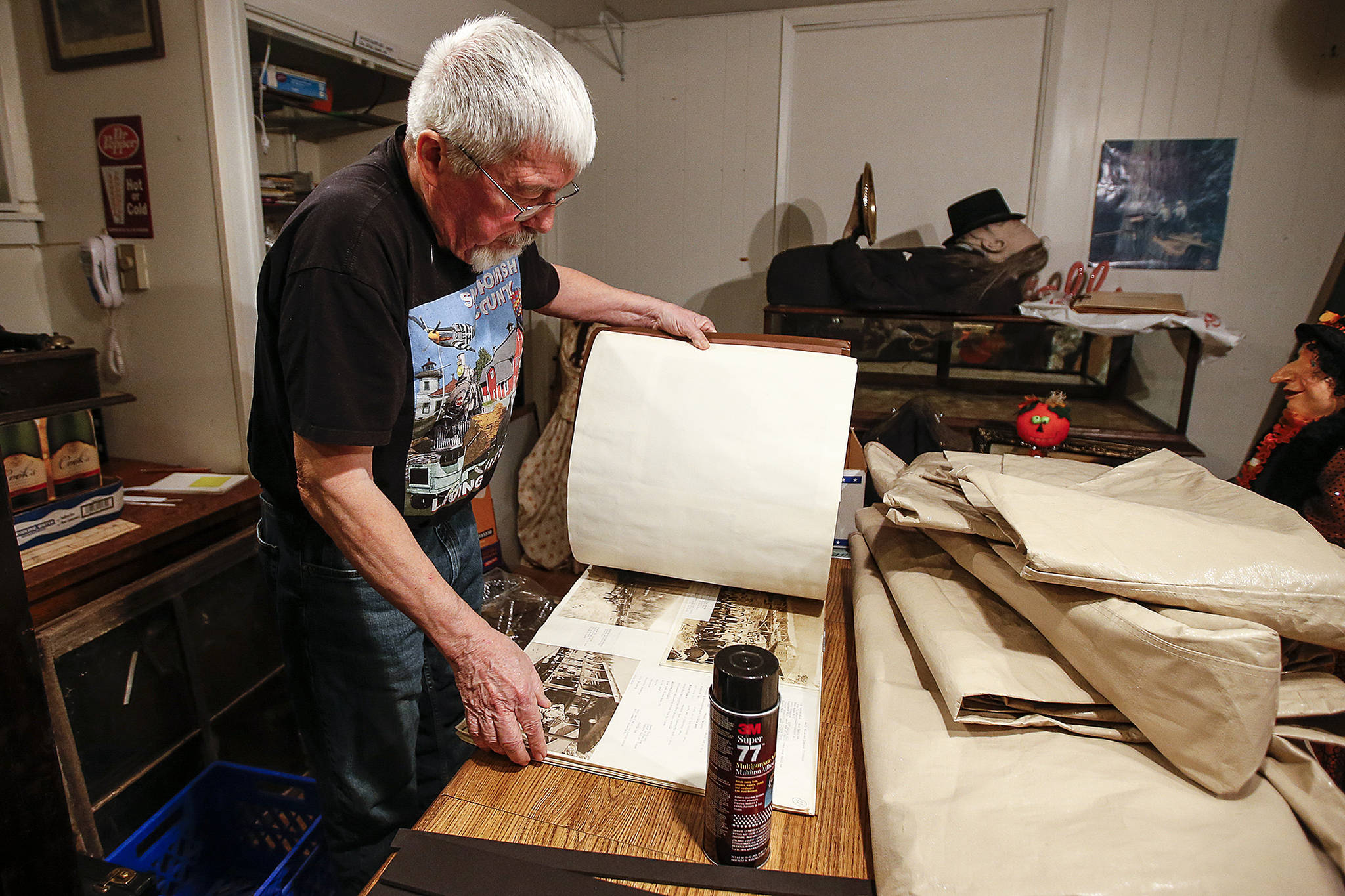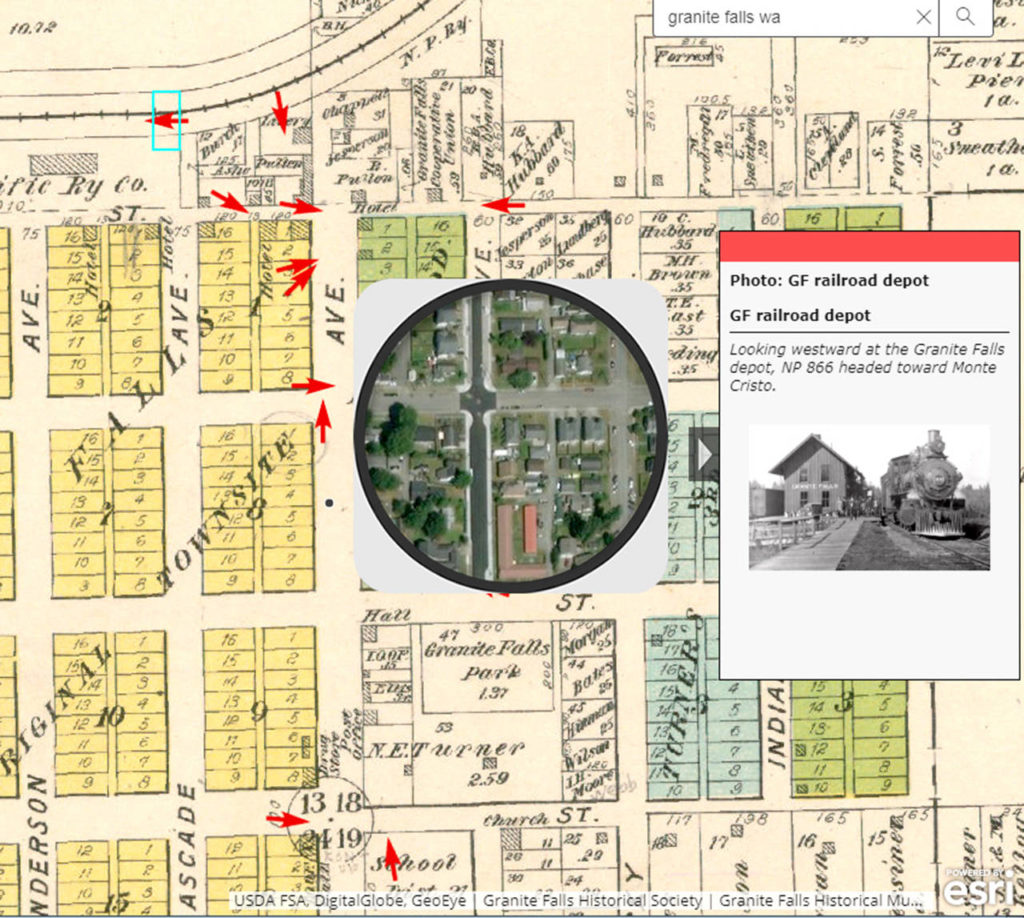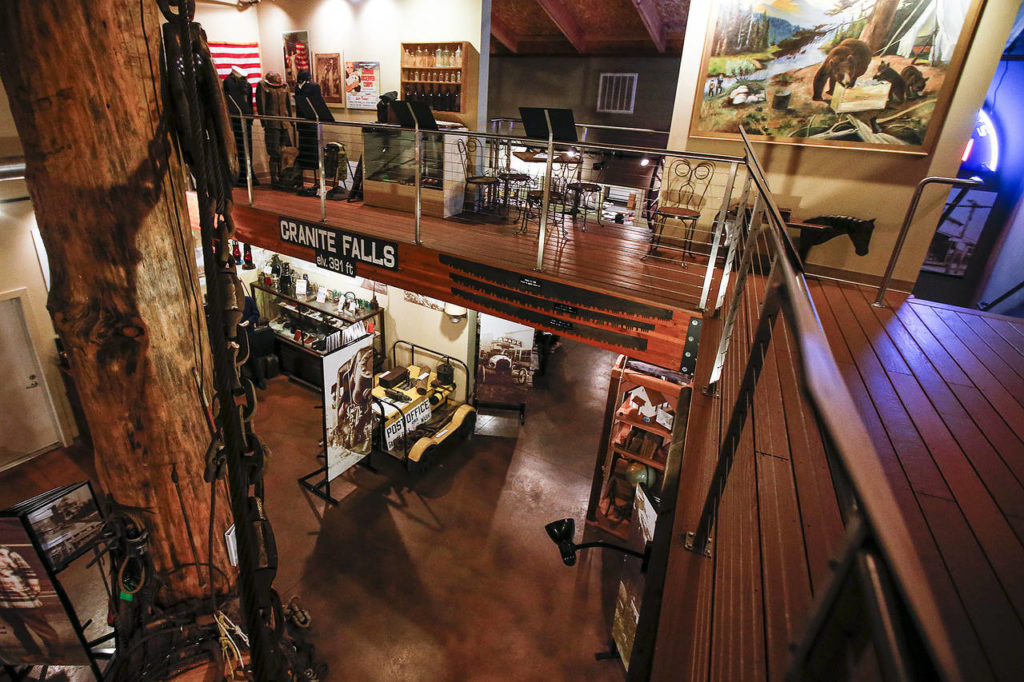GRANITE FALLS — The maps were neatly drawn and labeled in black ink on large sheets of paper, now yellowing and dog-eared.
They’re bound between black covers and stored in a wooden drawer at the Granite Falls Historical Museum. Some show original homestead lines, others the downtowns of the early 20th century. A few of those towns no longer exist, having vanished with the decline of their mines and mills. There are detailed fire insurance maps, too.
“We can tell you who had a one-hole and who had a two-hole outhouse,” said Fred Cruger, with the Granite Falls Historical Society.
But there are problems with the maps.
They aren’t all the same size, drawn to the same scale or covering the same areas. Comparing maps from one decade to the next, to see how Snohomish County has changed, is a challenge.
In digital form, though, the maps can be scaled, then layered, and with modern maps and aerial images. Photographs from generations past can be embedded, so a click of a mouse shows what someone would have seen from that spot 80, 90, 100 years ago. Some capture the heyday of towns lost to time.
Digitizing the maps took hundreds of hours. Volunteers georeferenced historical maps with modern coordinates, digitally drew homestead lines, typed in names and places, and added old photos. The scanning of those photos and other documents required hundreds more hours of work, before the mapping ever started.
There now are more than 300 gigabytes of data available on computer hard drives at local museums. Simpler versions of the maps are online.
They’re part of a string of projects, spanning 15 years, to preserve and share local history using technology.
The Granite Falls Historical Society has digitized thousands of photos, newspapers, yearbooks and maps, and built virtual history tours for smartphone users. In the process, it has involved high school students, other history organizations, volunteers and new businesses.
Historical societies have valuable collections to preserve, said Tom Thorleifson, president of the League of Snohomish County Heritage Organizations. But collection and preservation are only half the mission. Sharing information is the end goal. Technology continually offers new avenues.
“It’s this transition from the stereotypical museum to the modern world,” Thorleifson said.
A “technological revolution”
Granite Falls, a city of 3,500, celebrated its centennial in 2003. The historical society hosted monthly presentations.
The lowest turnout was 40 people, the highest about 300.
“They may not admit it, but there are a lot of closet historians around here,” Cruger said.
It became clear that people love old images and maps, especially paired with modern visuals to show change.
Discussions began about making available online many of the museum’s photos, documents and maps. Some worried that putting too much online would cause the nonprofit to draw fewer visitors and donations.
“Unequivocally, having this stuff available so people can find it has increased foot traffic,” Cruger said. “Our intent wasn’t advertising, but it worked.”
The organization sold CDs with old music to raise money for a computer and scanner. While making progress on its digital presence, the society also focused on its physical home. The museum launched a fundraising campaign in 2005 and finished an expansion in 2007.
Cruger sought volunteers who were computer savvy and motivated to put in long hours on what he calls a “technological revolution.” He recruited high school students who needed community service.
Samantha Hollo helped from the end of her freshman year until she graduated from Granite Falls High School in 2007. She logged nearly 500 hours.
“They just had boxes and boxes and boxes of photos and documents,” she said.
She sorted them by theme, identified as many people and places as possible, scanned each photo or page into the computer, and typed in information. Along with pictures, there were marriage and graduation certificates, advertisements, brochures and other papers.
Hollo now lives in Naselle near the Washington coast and was director of the Appelo Archives Center. She’d like to see every small-town history organization digitize their collections.
“It was so worth it,” she said. “We can’t let our history disappear.”
After two years and more than 6,000 items scanned, Cruger turned his attention to the museum’s piles of old newspapers. A then-fledgling Washington business, Small Town Papers, digitized those. Software scanned the newsprint to make the text searchable. Grant money helped Granite Falls and other museums pay for that work.
The Oklahoma State Department of Corrections reached out. As part of skills training for inmates, it offered to scan yearbooks for free, so the museum added those to its burgeoning digital collection.
Then came virtual tours. Anyone with a smartphone can take a narrated history tour of Granite Falls, the Mountain Loop Highway, Snohomish, Everett or the county’s aviation attractions.
“We had everything we needed,” Cruger said. “We had pictures, we had detailed information, we had classic historical information and we had maps.”
Mapping history
The digital maps have been used to research property and water rights, where ancestors lived and died, and long-gone buildings or communities.
The hard drives contain more data than what is online. Cruger warns that opening the website still can lead to hours of distraction.
One of the online maps features homesteads and maps from the first 100 years of the county. Another has detailed maps circa 1910. The third is an inventory of historic sites. All are layered with modern aerial maps.
Kyle Rood, who graduated from Granite Falls High in 2011, put in well over 100 hours georeferencing the historical maps to align with modern coordinates. He went with Cruger to a national convention in Oklahoma City to present the project.
Rood said he was amazed by the detail and accuracy of the hand-drawn maps. But it wasn’t easy putting them all together.
“We had to go through each section of the old maps and overlay it with the modern maps,” said Rood, now a senior studying accounting at Washington State University.
“It was a big task,” he said. “But it’s also very cool because it captures history in modern technology … When you’re able to bring all of these old things, these old maps, to a platform where younger generations can interact with them, that’s so important.”
The state Department of Archaeology and Historic Preservation honored the Granite Falls Historical Society for its education efforts.
Visitors stop by or call with questions. Cruger has used the museum’s digital collection to look up schoolhouses, fish farms and homesteads.
In one case, a man visiting from New Zealand asked about ancestors he believed had settled in the area. Cruger found that the man’s great-great uncle homesteaded 160 acres. It included the waterfall for which the town is named.
Access for all
To share information with the public, it helps when history groups share with one another, Thorleifson said.
“All of the individual groups have their own strengths and their own things they’re working on,” he said. “Museums want to protect and preserve what they have. Papers become brittle. You have to archive it.”
There still is uncertainty about digital collections. Organizations rely on visitors, memberships and donations. It takes money, knowledge and time to digitize information. Cruger said his team has been fortunate with grants, skilled volunteers and free or discounted services.
He recently trained volunteers at the Stillaguamish Valley Genealogical Society on the mapping system. The society is working on a book about early schools in the valley, and offered to provide photographs to add to the maps.
The Stillaguamish Genealogy Library has done its own work online. Its 6,000-plus books are catalogued on the website, which recently was updated to handle membership and book sales.
Technology has sparked interest in genealogy, said Ruth Caesar, president of the group. DNA testing and online family trees connect people. The Washington State Digital Archives and Library of Congress Digital Collections are among other tools. The local mapping system shows homesteads and property ownership through the years.
“It is really a revolution,” Caesar said. “It’s a thought process. You have to get your mind around the things you can do with a computer … You can research from your couch.”
That doesn’t take away from museums or libraries, she said. That’s where you find the experts, and artifacts or books that aren’t online.
Cruger expects more local museums to increase their online presence. Small Town Papers plans to start providing free online hosting for nonprofits’ digital content.
Technology continues to evolve, offering new ways to glimpse the past.
A railroad aficionado is working with the Granite Falls Historical Society on a digital version of the railroad that once ran to Monte Cristo. He laid virtual train tracks based on historical maps. The museum’s photo collection will help accurately depict buildings and landmarks. Once complete, the system should let users be engineers driving virtual trains from their screens.
“It’s got every bridge, every switch, every tunnel exactly where it was and how it was,” Cruger said.
It’s another example of how technology can celebrate history.
“You never know what’s going to happen next,” Cruger said.
Kari Bray: 425-339-3439; kbray@heraldnet.com
Find history
Maps: www.gfhistory.org/Maps.html
Smartphone tours: www.gfhistory.org/VirtualTours.html
Newspapers: www.stparchive.com
The Granite Falls Historical Museum is at 109 E. Union St., open noon to 5 p.m. Sundays or by appointment: info@gfhistory.org.




























